China is the second largest country in land area, with snow-capped mountains, deserts, rivers, canyons, fertile plains, and 56 different ethnic groups. The Han constitute 91% of China’s population, followed by Tibetans, Mongols, and Uyghurs. Pre-imperial China was ruled by competing dynasties and semi-autonomous kingdoms. In 221 BC, the Qin State united the country’s secular and clerical fiefdoms and began construction of the Great Wall of China. During the Han Empire, from 202 – 220 BC, Confucianism was introduced throughout the country. China’s last dynasty, the Qing, brought a period of peace and prosperity. It collapsed in the early 20th century under the weight of mass uprisings and the Boxer Rebellion.
In 1912, Sun Yat-sen and the Kuomintang (Nationalist Party) introduced a constitutional republic. Although China’s Communist Party joined forces with the Nationalists in 1924, divisions between the Nationalists, led by Chiang Kai-shek, and the Communists, led by Mao Zedong, led to the outbreak of civil war in 1930. During this period of instability, Japan invaded Manchuria and declared war on China in 1937. The Second Sino-Japanese War unified the Nationalists and Communists but decimated the country. When Japan surrendered at the close of World War Two, China’s civil war rekindled. Efforts by the United States to broker a peace agreement failed. After four years of brutal fighting, Mao’s Communist Party prevailed and the Nationalists fled to Taiwan (Formosa).
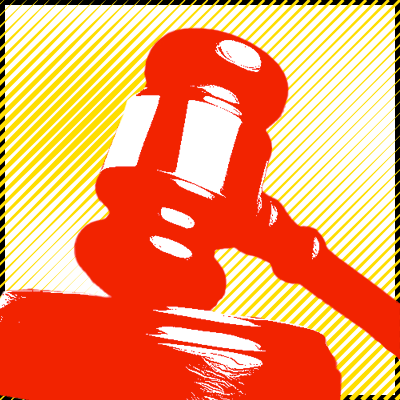
Sources of Law
Sources of law in China include the Constitution of the People’s Republic of China, national laws issued by the National People’s Congress, administrative regulations promulgated by the State Council, decrees from local People’s Congresses, administrative orders, and local rules. Chinese courts also rely upon “judicial interpretations” issued by the Supreme People’s Court; these interpretations may arise from Court rulings or be issued independently. Lower courts are not empowered to interpret or declare invalid laws, rules, or regulations. This function is exercised by the Standing Committee of the National People’s Congress.
Judicial System
In China, the courts, prosecuting authorities, and public security are all part of the judicial system. Each branch is under the authority of the National People’s Congress.
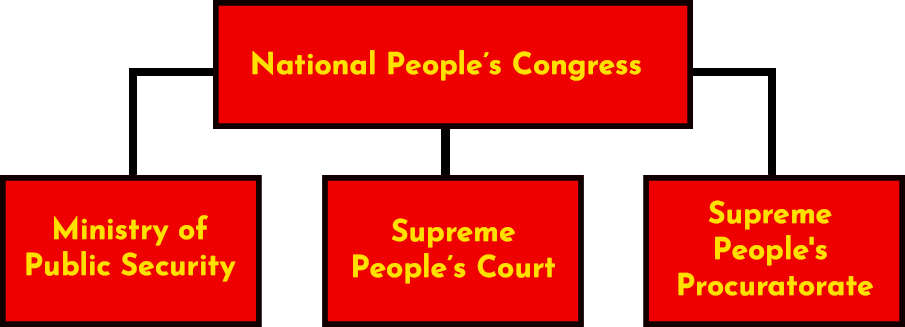
The National People’s Congress is the national legislature and the highest political entity in the country. There are 3,000 delegates elected for five-year terms by the provinces, municipalities, and autonomous regions. Law-making authority is reserved for the Congress’ Standing Committee.
The Courts
The Organic Law of the People’s Courts sets forth the judiciary’s structure, personnel rules, and powers. China has a unified court system with four levels: the supreme court and three levels of local courts (high, intermediate, and basic). The local courts hear both first instance and appellate cases from their territorial designations.
Communist Party Group and Court Leadership
Each level of the judiciary has its own hierarchy. At the apex is the Communist Party Group (CPG), an institution with ten members including the court president and other high ranking court officials. The CPG has broad administrative authority. The Judicial Division and an Administrative Department sit below the CPG; the judge leading the Judicial Division is responsible for reviewing and approving court judgments and orders. Court presidents are responsible for the performance of subordinate judges and are assessed (rewarded or punished) based upon their courts’ overall performance.
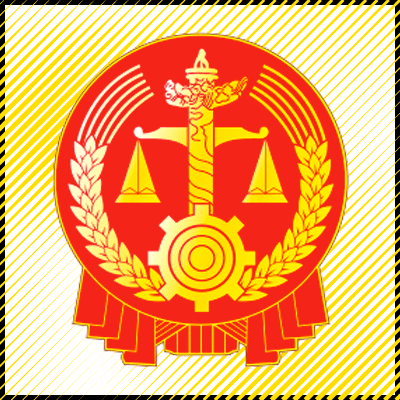
The Supreme People's Court (SPC) , China's apex court, reviews lower court judgments, hears certain first instance disputes, administers the judiciary, and issues binding interpretations on how to apply laws and writs. It also hears cases from the Hong Kong Office for Safeguarding National Security, reviews protested cases filed by the Supreme People’s Procuratorate, and issues death penalty sentences. The SPC has supervisory authority over the lower courts; China’s constitution gives the National People’s Congress supervisory authority over the SPC.
The court has three permanent divisions: criminal, civil, and economic; other divisions are created as needed. Within the civil division, there are subdivisions, including the 4th Civil Division that hears all cases involving foreign law and parties. The court’s administrative powers are extensive and are carried out by various offices, departments, and bureaus, including: research, general affairs, personnel, judicial discipline and supervision, administrative affairs, foreign affairs, and education. Each administrative unit is led by one of the court’s justices.
The SPC has over three hundred judges who all work in Beijing, where the court sits. The National People’s Congress elects the court’s president to a five-year term, renewable once. Its Standing Committee appoints the other members of the court (upon the court president’s nomination) and has authority to dismiss court leadership, including supreme court justices.

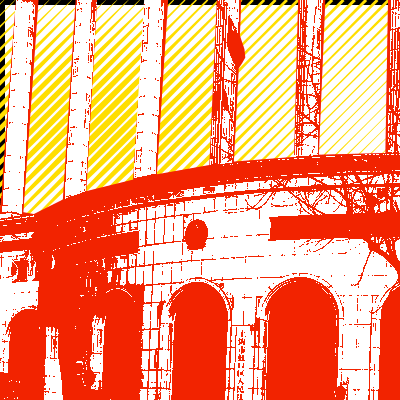
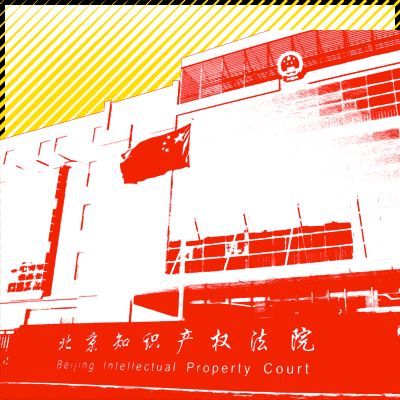
Each level of China’s local court system follows a two-hearing model: if a litigant is unhappy with the outcome of their first court proceeding, they can appeal to a court of the next higher level. The second court’s decision is final.
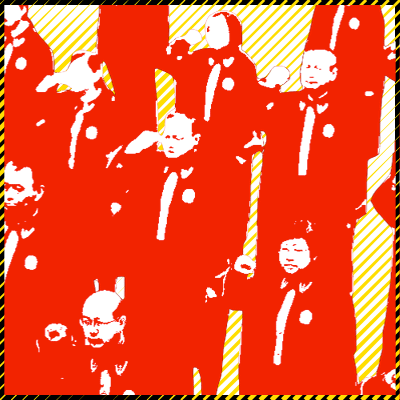
Judicial Selection
Historically, many Chinese judges were appointed from the military, often without prior legal education or experience. China now recruits judicial candidates through an open exam process. Applicants must meet political and physical standards, pass a national bar exam in addition to the civil service exam, and sit for an appraisal of their qualifications. Those with an undergraduate degree must have 1 – 2 years work experience before joining the judiciary; graduates of masters programs in law may become judges directly after university. First instance judges are eligible for promotion to higher courts. Under a recent reform, members of the bar are also eligible for judicial appointment. Local court presidents are elected by the local people’s congresses. The court president appoints the vice president, presiding and deputy presiding judges, and assistant judges.
Court Personnel
Many professionals work in Chinese courts: judges who serve in leadership roles (court presidents, vice-presidents, deputies), members of the adjudication committee (see below), judges who adjudicate cases, assistant judges, law clerks, court clerks, and judicial police. The assistant judge helps judges with trial support, reviewing case materials, and drafting legal documents. An assistant judge may assume the functions of a judge, provisionally, upon the recommendation of the court president and with the approval of the judicial committee; many eventually are promoted to full judge. Court clerks interact with the public, handle pre-trial preparation, manage court records and files, create a record during court proceedings, and complete other tasks assigned by judges. Judicial police provide courthouse security and safeguard personnel.
Judicial Performance Evaluation
As is the case for all government officials in the country, Chinese judges undergo regularly scheduled quantitative performance assessments. In 2011, the Supreme People’s Court introduced a nationwide assessment system, the Case Quality Evaluation System. Its two principal metrics are efficiency (case disposition rates) and accuracy (low levels of reversal on appeal). The system also includes public satisfaction surveys. Judges are rewarded for strong performance through promotions and bonuses. Sanctions for underperformance include mandatory training, adjustment to grade or salary, and dismissal.
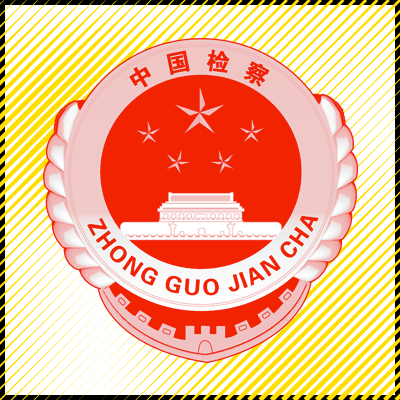
The Procuratorate
The People’s Procuratorate serves both a prosecutorial and supervisory role. There are specialized procuratorates, including one for the military. The Supreme People’s Procuratorate (SPP) is the highest prosecuting authority and reports directly to the National People’s Congress. It sets criminal justice policy and serves as public prosecutor in serious criminal cases including those involving national security. The SPP supervises the work of regional and local procuratorates, public security organs, people’s courts, and prisons; it also has oversight authority over civil and administrative proceedings. The SPP has authority to file protests with the SPC over verdicts rendered by the people’s courts that it deems erroneous.
China enacted a new criminal code in 1997 in an effort to bring its criminal justice system in line with international norms. The code codified rights of the accused and protections for suspects, defendants, and victims. However, these prescribed safeguards can be undermined by informal rules and practices.
Plea Leniency System
In an effort to both expedite criminal proceedings and make them more equitable, China introduced a new provision of the Criminal Procedure Code in 2018 allowing for “plea leniency.” The accused may plead guilty and take responsibility for their conduct in exchange for a more moderate sentence. The system is used for crimes ranging from minor personal injuries to homicide and drug offenses. The plea leniency process can take place at any stage of a criminal proceeding.
Plea leniency is prosecutor-led: they initiate discussions with defense counsel, decide upon the proffered sentence, and oversee the defendant’s acceptance of responsibility. The judge’s role is limited to a single, perfunctory court hearing. The plea leniency system enabled significant reduction of criminal case disposition rates. However, some commentators have noted its potential risks, including human rights violations.
Civil Proceedings
When a plaintiff initiates a civil suit in China, the complaint is first screened by judges in the court’s Case Filing Division. This division has full discretion to review allegations and evidence; it must accept or reject the suit within seven days. The complainant may appeal a written order of rejection. Accepted cases are docketed and the court has five days to serve the defendant. The defendant has fifteen days to answer in writing, but there is no sanction for failing to answer; many defendants do not submit a response until the first court date. In simple cases, Case Filing Division judges may contact the parties by phone to encourage settlement.
Cases not disposed of at this stage are assigned to a civil division judge. Less complex cases are adjudicated by a single judge, pursuant to a simplified trial procedure: after first attempting mediation, the judge gives parties a certain period of time, depending upon the complexity of the case, to produce evidence in court. Two time-extensions are permitted. Each party must produce facts to support their position. Parties cannot compel their opponent to produce evidence, but they may request the court to conduct its own investigation and gather evidence that they cannot access. The court has discretion over whether to pursue an investigation.
More complex civil cases and those being adjudicated for a second time are heard by a collegiate bench: an odd number of judges (most often three) or a combination of judges and People’s Assessors (see below). The presiding judge of the panel is responsible for pretrial matters and leads the proceedings. The other panel members (judges and assessors) often defer to the opinion of the presiding judge.
Most evidence in civil cases is documentary, including written witness statements rather than live testimony. Trial proceedings may include only oral arguments and questions from the judge. The presiding judge issues the judgment or order in writing. More complex or sensitive cases may be referred to the court president who in turn may refer the case to the adjudication committee.
Adjudication Committee
Each level of China’s court system has an adjudication committee. Although not a court, it serves as the highest body of judicial authority for complex and sensitive legal issues. Its discussions are classified as state secrets and do not become part of a formal trial record.
Adjudication committees review litigation involving national security, capital punishment, foreign parties, matters involving Hong Kong, Macau, or Taiwan, and cases of significant social importance. The committee reviews case reports summarizing the facts, major issues of contention, and preliminary judgments. The committees do not hear party testimony or arguments.
Committee members include the court’s leadership (president, vice-presidents, and heads of the trial divisions) as well as permanent committee members. The head of the procuratorate and members of the judicial panel hearing the case may attend committee hearings.
Judicial Independence
Many features of China’s system do not comport with internationally recognized pillars of institutional judicial independence. These include the role of the Communist Party in judicial affairs, the oversight exercised by adjudication committees, limits on the decisional autonomy of lower court judges, the influence of local government officials on court decisions, the authority of the procuratorate, and the absence of transparency in many court proceedings. Each level of government in China has a Political-Legal Committee that supervises the work of government institutions, including the courts. The majority of cases are not affected by this phenomenon, but the committees can influence sensitive and important cases.
China introduced reforms intended to enhance the decisional independence of judges. For example, it now limits the types of cases sent to adjudication committees. The central government also enacted changes to limit the influence of local governments on their judiciaries. But, this resulted in assigning more administrative oversight to national authorities.

Lay Assessors
In the early 19th century, China began using citizen lay assessors in court proceedings. Lay assessors may express opinions on the evidence and facts of a case but cannot comment on which laws should be applied. The lay assessor system continued during the early part of the communist era but was dismantled during the Great Leap Forward and Cultural Revolution. When a new constitution was enacted in 1978, the lay assessor system was revived and codified.
In 2018, China introduced a new Lay Assessors Law that accorded assessors authority equal to that of a judge, without the right to hear cases independently or serve as panel president. Lay assessors now may sit on seven-person judicial panels in death penalty cases.
Citizens who are high school graduates and at least 28 years old are eligible to serve as lay assessors. They are selected randomly from the local community. As of September 2022, lay assessors participated in trials of more than 2.15 million criminal cases, 8.79 million civil cases and 780,000 administrative cases nationwide.
Guiding Opinions
In 2020, the SPC introduced a new rule to create greater consistency across court rulings. The “Guiding Opinions” rule requires courts to search “similar cases” – previous cases with analogous fact patterns or legal issues. The rule directs courts to search four categories of cases: Guiding Cases issued by the SPC, model SPC judgments, reference cases issued by provincial-level higher people’s courts, and judgments of the next higher and same-level courts.
The Guiding Opinions rule is invoked when applicable legal principles are not clear, a court president or division head so requires, or when a case is submitted to a specialized judges’ meeting or adjudication committee. Although China does not recognize precedent, the Guiding Opinions rule institutionalizes consideration of previously decided cases and frames prior cases as a contributing – not binding -- factor in a court’s judgment.
